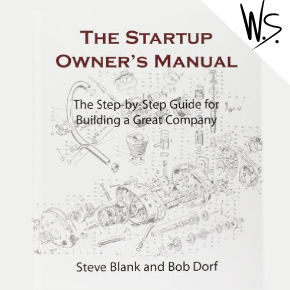启动用户手册:总结和回顾
书评
的概念 初创企业用户手册 这本书就像是一本汽车维修手册,但针对的是初创企业。在这本书中,史蒂夫·布兰克和鲍勃·多尔夫详细介绍了在推出产品之前需要做的所有工作(和有趣的事情)。由于信息量巨大,这本书很厚。事实上,它的大小可能最像汽车手册。“一次不要读太多。”这个警告在书开始之前就出现了。认真对待。
该组织可能会令人困惑。虽然本手册将引导读者按顺序完成启动启动的必要任务,但它同时遵循两个不同的轨道。有 网络/移动渠道——您的 IT、新经济类型渠道——以及 实体渠道——实体店。作者表示,无论你的产品属于哪个渠道,阅读这两个部分都很有帮助。在最初的困惑之后,这位评论者个人发现,将两个渠道并排考虑是发人深省的。而且,差异化的字体也很有用。
尽管这里提供了这么多信息,但还是很容易迷失。为了解决这个问题,这里提供了很多检查清单。所以,如果你需要检查清单,天哪,你会在这里找到它们(附录包含 60 页检查清单)。
概括
入门(第 1 章和第 2 章)
作者提醒我们,旧的产品推出流程对初创公司来说是完全错误的。当客户已知且市场定义明确时,该过程是合适的。对于初创公司而言,情况通常并非如此。
因此,客户开发对于初创企业来说非常重要,Blank 和 Dorf 的框架包含多个阶段:
- 客户发现:提出假设并与客户一起测试。
- 客户验证: 测试销售,看看人们是否会购买,看看你是否可以扩大规模。
- 客户创造: 营销。
- 公司大楼:过渡到可持续发展的企业。
每一步都是迭代的,可以根据需要重复。此外,在任何时候,都可能需要调整或改变策略。这没关系——这不是失败。
第一步:客户发现(第 3-7 章)
你必须了解你的客户,不要对他们妄下结论。布兰克和多夫(以及许多其他人)提出的一个重要观点是,客户并不住在你工作的地方。为了与他们在同一层次上会面,你必须“走出办公室”。
初创公司的目标应该是通过最小可行产品 (MVP) 为小目标市场开发第一个产品。 MVP 的目标是为早期的适配器(称为 早期布道者 (点击此处)进行尝试。推出 MVP 迫使开发人员专注于重要功能,而不是花哨的东西。一旦收到客户反馈,产品就可以得到改进。
商业模式规划: 作者推荐 商业模式画布 (亚历山大·奥斯特瓦德的 商业模式生成) 作为帮助解释公司计划如何赚钱的好工具。画布有许多组件:
- 价值主张假设:包括产品愿景、功能和优势,以及制作独立产品(即 MVP)所需的最少功能描述。在网络/移动端,低保真 MVP 用于测试您是否已确定人们关心的问题,并且它使用用户故事而不是功能列表。
- 客户细分:包括客户问题、需求或热情;客户类型(例如,最终用户、影响者、推荐者、买家等);客户原型;客户生活中的一天;以及客户组织和影响图。
- 渠道假设:对于实体产品,这包括产品如何到达客户手中的描述。考虑渠道对您的产品的适用性,作者建议初创公司只选择一个对您的产品最有潜力的渠道。对于网络/移动产品,请考虑不同渠道的优缺点。
- 市场类型和竞争假设:描述产品适合哪个市场:已建立的市场、新市场、现有市场的扩展、重新细分等。一旦你了解了市场,你就对竞争有所了解,你就可以来并为此制定了初步计划。
- 客户关系假设:描述您将如何获得、留住和发展客户。对于实体产品,有四个“获得”阶段——认知、兴趣、考虑和购买。设计几种不同的“获得”策略并进行测试。客户保留计划在“保留”阶段发挥作用,“发展”阶段专注于向现有客户销售更多产品。对于网络/移动产品,“获得”阶段有两个阶段,即获取和激活,这两个阶段相互循环。“保留”阶段可能涉及一些与实体产品相同的保留计划,但也可能包括电子邮件、数字支持等组件。“发展”阶段涉及让现有客户花更多钱或为产品带来其他客户。
- 关键资源假设:描述物质、财务、人力和知识产权资源。此部分还包括依赖性分析:公司无法控制的所有必然事件是什么,如果您所依赖的事物最终失败,风险是什么?应急计划在这里很重要。
- 合作伙伴假设:列出您需要的所有合作伙伴,并确定您需要他们提供什么以及他们将获得什么回报。
- 收入和定价假设:包括以下问题:1)我们将销售多少件商品?2)收入模式是什么?3)我们将收取多少费用?4)是否有证据表明这值得追求?
使用此工具超越一次性计划,每周更新一次。随着时间的推移,您将拥有公司发展的记录。
市场规模:在估计您的市场规模时,一种思考方式如下:
- 总可寻址市场 (TAM):您的产品所在的世界
- 服务的可用市场 (SAM):可以通过您的销售渠道接触到的人
- 目标市场:最有可能的客户
你必须在这里做研究。查看行业报告、新闻稿、图书馆——任何可以获得有助于衡量市场规模的指标的地方。估计全新的市场将会很棘手,因此请考虑查看相邻市场,看看是否能找到任何可比的公司。
测试客户的问题:你必须走出大楼才能发现:
- 你对客户问题的了解程度
- 问题对客户有多重要,到底有多少客户在谈论它
- 如果客户足够关心它会告诉他们的朋友
从广义上讲,问题发现过程包括以下五个步骤(并注意:这个过程对于网络/移动产品比实体产品更快):
- 为客户测试设计实验:简短、简单、客观的通过/失败测试,不仅旨在收集数据,还旨在获得洞察力。
- 准备好与客户联系:对于实体产品,请联系您可以测试您的想法的潜在客户。对于网络/移动产品,这涉及开发低保真 MVP,它可以像说明问题、向人们展示您的解决方案并征求客户反馈的小册子或网页一样简单。
- 测试客户如何看待问题:实物产品的问题展示(不是产品演示),说明您对问题的理解和您提出的解决方案。对于网络/移动产品,您可以在这里测试您的低保真 MVP,验证您的假设以及您对客户的所有假设。
- 了解客户:这不仅仅是验证有关客户问题的假设;它需要了解客户如何过他们的日常生活,以及他们目前如何(或不,视情况而定)解决问题。
- 获取有关市场和竞争的信息:了解实体产品的运行环境可能涉及参加贸易展览、会议、竞争对手的午餐等。这些工具也适用于网络/移动产品,Alexa 等流量测量工具也适用.
测试您的解决方案:在客户问题测试之后,这个阶段测试解决方案,作者在这里详细说明了五个步骤:
- 更新业务模式和团队:查看新信息与旧假设的契合程度,并决定是否需要改变策略(转型)或继续进行是否合理。这也是与高层管理人员和投资者分享您迄今为止了解到的有关客户的信息的时候。
- 创建产品解决方案演示(物理)或高保真 MVP 测试(网络/移动)
- 测试产品解决方案:通过向客户询问所有内容(包括功能、渠道等)来了解客户的想法。对于网络/移动产品,衡量客户行为。
- 更新业务模式(是的,再次):利用您从解决方案测试中学到的知识,更新业务模式并决定(是的,再次)是转型还是继续。此阶段客户热情低落是一个巨大的危险信号!
- 寻找董事会成员:获得一些友好的外部帮助是件好事。
验证商业模式:还没有启动,客户发现过程的这个阶段涉及回答三个关键问题:
- 您是否找到了产品与市场的契合点?你 有 确保你的产品适合市场。这是很多人需要的东西吗?它能多好地解决它要解决的问题?有多少人会买这个东西?
- 谁是您的客户,您如何接触他们?
- 您能赚钱并发展公司吗?弄清楚您的解决方案是否是一个成功的方案。计算数字并进行粗略估算,看看您的新产品是否有机会赚钱。
而且,您猜对了,此时您应该再次暂停并决定是旋转还是继续。
第二步:客户验证(第 8-12 章)
客户验证意味着在流程的每个阶段进行测试销售(同时保持低成本——现在还不是扩大规模的时候)。Blank 和 Dorf 详细介绍了客户验证流程的四个阶段:
- 第一阶段。 准备出售。
- 第二阶段。 去直播。尝试出售。
- 第三阶段。 完善您的产品。定位您的公司。
- 第四阶段。 分析。旋转或继续。
创始人 不能 从远处引到这里;他们必须直接参与过程。
第一阶段——准备出售
这一阶段的客户验证步骤对于每个渠道来说确实是不同的,因此分别考虑每个渠道是有帮助的。
对于实体产品,这个阶段从定位声明开始:一条信息(应该简洁但引人注目)解释人们为什么应该购买你的产品。然后,以客户为中心的销售和营销材料应主要根据您在为客户发现过程创建的假设中生成的信息开发。 (请记住,在这个渠道中获取客户是一个意识、考虑、兴趣和购买的四个阶段的过程。)作者建议现在是让销售专业人士加入的好时机。
你和你的团队还需要制定销售渠道路线图,该路线图涵盖组织食物链中的组织、分销渠道中的关系以及渠道中的资金流动方式。在管理渠道时,要处理与渠道合作伙伴的关系。想想你需要他们做什么,他们需要你做什么。不要指望你的渠道合作伙伴能帮助创造需求。
然后,您将制定销售路线图,该路线图涵盖从第一次销售电话到签订合同的每个步骤。记住您对客户的了解,并重新查看您在客户发现阶段开发的一些材料(尤其是组织和影响图)。制作购买流程模型,并确定关键影响者。
客户访问图可以帮助您识别客户所属的组织(如果您向公众销售)或组织中的关键决策者(如果您向企业销售)。将所有地图放在一起,同时考虑销售策略,并编写一个实施计划,显示销售产品前必须发生的所有事情。
对于网络/移动产品,准备销售阶段包括首先完善计划和开发工具以获取和激活客户。记住: 获得 是当客户第一次听说产品并且 激活 是客户参与、注册或做某事的时候。除非激活计划已为客户做好准备,否则不要启动获取工作,而后者的关键是参与度。此外,要衡量一切!
然后,利用你收集的构建以前版本的信息,你将构建一个高保真 MVP,它将比上一个版本具有更多功能。它肯定更精致,但它仍然不是完整的成品。一定要尽可能多地收集客户对新 MVP 的反应数据。从那里开始,收集数据、分析和优化——从网络/移动业务打开虚拟大门的那一刻起,直到它消亡的那一天。
使用客户关系假设来指导您选择要跟踪的指标并确定其优先级。仅跟踪您可以衡量和改进的内容:获取(您的网站有多少访问者?他们是从其他网站推荐来的吗?);激活(激活了多少次?他们在网站上浏览了哪些页面?);以及推荐(有多少人是从现有用户推荐来的?这些推荐的接受率是多少?)使用仪表板或类似的东西来关注数据。说到数据,您需要有人来处理数字,Blank 和 Dorf 建议聘请数据分析主管。这个人应该是高级管理人员,他们应该有影响力。它可以是您团队中的现有成员,也可以是新成员。
最后,在适用于实体产品和网络/移动产品的作者建议中,招募并保留能够帮助您的董事会成员。他们有重要的人脉吗?他们是否有真正可以帮助公司的好主意?很多时候,让客户加入董事会很有帮助。他们可以带来他们的观点。
第二阶段——走出大楼,开始销售
在此阶段,您正在验证您的商业模式假设,但您仍在测试(通过实际销售)。不要试图扩大规模——销售的目的是为了测试您的商业模式。
对于实体产品,你不需要很多客户,只需要几个。记住那些早期采用者/早期布道者? 这些人是您的自然市场。但请不要忘记,激励他们的原因可能与激励普通人的原因不同。客户有多种类型(例如,早期评估者、早期推广者、可扩展客户和主流客户),您应该针对每种客户制定单独的策略。
客户对实物产品的兴趣是通过查看人们愿意为闪亮的新事物支付多少来测试的。也许给人们从(你说的是)全价的折扣,但不要太多。 (可预见的非理性 经过 菲利普·E·泰洛克 和 丹·加德纳 对定价方案有一些很好的见解。)无论如何,出去销售。一旦你有了销售,你就会有数据。收集所有数据。但要注意:你的 Shiny New Thing™ 是否得到了客户的热烈响应?没有那么多?是因为测试销售需要修复某些东西,还是产品出了问题?在这里注意你的转折点或继续前进的时刻。
您的销售方法取决于您是向消费者还是公司销售。对于公司,您要尝试接触具有决策权的高管。对于公众,您要细分市场。拿出您以前的销售路线图;这是与销售副总裁沟通的重要方式。将路线图写成流程图,并包括流程的每个步骤。别忘了:销售完成后,必须有人跟进实际交易,确保客户得到他们想要的东西。确保这是您路线图的一部分。
最后,一旦有了客户,您就可以测试销售渠道。联系潜在的渠道合作伙伴,分享一些指标和预测;告诉他们您的想法。您应该问他们有关渠道的问题 - 例如,他们想要多少百分比?他们可能会立即接受您的报价,或者他们可能想先通过在他们的商店销售您的产品来测试您的想法,看看他们是否表现良好。查看一些不同的潜在渠道合作伙伴。
换个角度,对于网络/移动产品,您需要准备优化计划和工具。优化就是要从所有方面获得更多收益 — 例如,如果您的激活率为 6%,请尝试将其提高到 10%。尝试在您测量的每件事上取得可衡量的改进。这是一个持续的过程,直到企业倒闭或上市才会结束。优化应侧重于增加数量、降低每个激活客户的成本以及增加访客到用户的转化率。作者就优化测试提出了一些建议:
- 知道你在测试什么以及为什么测试
- 不要过度测试
- 应控制测试并遵循公认的协议
- 记住客户一生的价值,而不仅仅是这一笔交易
对于网络/移动产品,获取更多客户的策略取决于您的业务模式。例如,订阅服务可能会为新用户提供免费试用。一定要关注以下问题:什么是重要的,什么是令人失望的,什么会带来最好的客户,等等。测试各种激励措施和折扣。不要一次优化太多东西。你需要确定原因和结果。
但一定要优化“保留”和“增长”部分。保留老客户比获得新客户更便宜。在关注“保留”时,请回顾您的客户关系假设,您在此提出了一些保留客户的想法(忠诚度计划等)。推出其中的一些。一定要跟踪所有内容。有些计划比其他计划便宜,因此请跟踪您的成本。在“增长”部分,让您的客户购买更多产品(也许为大订单提供折扣和类似策略),并让您的现有客户吸引新客户。
最后,您需要合作伙伴来为您的新网站带来流量,并且有一些使用合作伙伴网站来推广您的网站的策略。但如果潜在合作伙伴对您的电话营销不感兴趣,请不要感到惊讶。尝试强调与您合作的好处。
第三阶段——定位阶段
你的定位应该与你的市场相匹配。对于现有的市场,你要与众不同,但又要可信。你要解决对人们来说很重要的问题。
对于一个新市场,您想解释一下您的愿景。你的公司试图改变什么?
此时,回头看看您在客户验证阶段撰写的定位声明。它是如何通过验证过程的?如果客户不喜欢它,您知道原因吗?此外,与您在客户发现阶段确定的关键影响者会面。现在是与他们会面的时候了。测试一下这些影响者和其他行业分析师是否会对您说好话。
最后,不要让任何人告诉你你需要一家公关公司——此时,你的客户开发人员在产品开发人员的帮助下就可以很好地完成这项工作。但一定要进行职位审核,看看其他人如何看待你的公司和你的产品。这将为你提供一个比较的基准。
第四阶段——转型或继续前进
这可能是您将要经历的最关键的转折和进展。审查和分析您生成的所有材料;确保对假设有可靠的答案。看看您的业务模式以及它是如何通过这个过程发生变化的。您的指标是否提供了证据表明这是一项可扩展的努力,可以带来利润?这很重要,作者对“重要的指标”提供了见解(例如,销售单位总数、销售价格等)。
查看您的财务模型。收入增长曲线因市场类型而异:新市场公司的增长在图表上看起来就像曲棍球棒,先慢后腾;现有市场显示出稳定的增长速度。您拥有的数字是您最好的猜测,但请记住,没有什么是确定的,即使是在游戏的后期。还要重新评估商业模式、价值主张和产品交付,以确保它们是合适的。收益要高,成本要低。
简而言之,重新审视一切。完成所有这些工作后,重新回到绘图板上可能很难,但如果这是你必须要做的,那也没关系。否则,如果一切顺利,就休息一晚。不,休息一周。你需要休息。还有很多工作要做。
